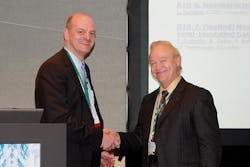Researcher Michael Fiederle wins Room-Temperature Semiconductor Detector Award

Freiburg, Germany--Albert-Ludwigs-Universität Freiburg materials researcher Michael Fiederle has been chosen to receive the "Room-Temperature Semiconductor Detector (RTSD) Award." The award honors extraordinary scientific contributions to the topic of semiconductor radiation detectors. Fiederle accepted the RTSD Award in November at the international Institute of Electrical and Electronics Engineers (IEEE) Nuclear Science Symposium and Medical Imaging Conference 2010 (Knoxville, TN), an event attended by about 2000 scientists.
The RTSD steering committee selected Fiederle for his dedication to research on the material characteristics of semiconductor detectors as well as the further development and testing of this technology for imaging procedures. Detectors for x-ray, gamma, or neutron radiation are applied in areas such as internal security, astrophysics, medicine, and environmental protection. Gamma-ray detectors, for instance, are used at border crossings to prevent people from smuggling radioactive material over international boundaries.
Fiederle and his team at the Freiburg Materials Research Center have developed innovative detector systems in the areas of medical technology and nondestructive testing on the basis of the so-called Medipix pixel electronics. These systems are the first to enable high-resolution color x-ray imaging. In addition to 3D imaging for medical diagnostics, the scientists also conduct research on environmental radioactivity. For example, in a recent collaboration with the German Federal Office for Radiation Protection they developed a detector system for the spectroscopic surveillance of radioactivity in the atmosphere. The technology will be at more than 2,000 measuring stations nationwide.
Subscribe now to Laser Focus World magazine; it's free!
About the Author
John Wallace
Senior Technical Editor (1998-2022)
John Wallace was with Laser Focus World for nearly 25 years, retiring in late June 2022. He obtained a bachelor's degree in mechanical engineering and physics at Rutgers University and a master's in optical engineering at the University of Rochester. Before becoming an editor, John worked as an engineer at RCA, Exxon, Eastman Kodak, and GCA Corporation.
